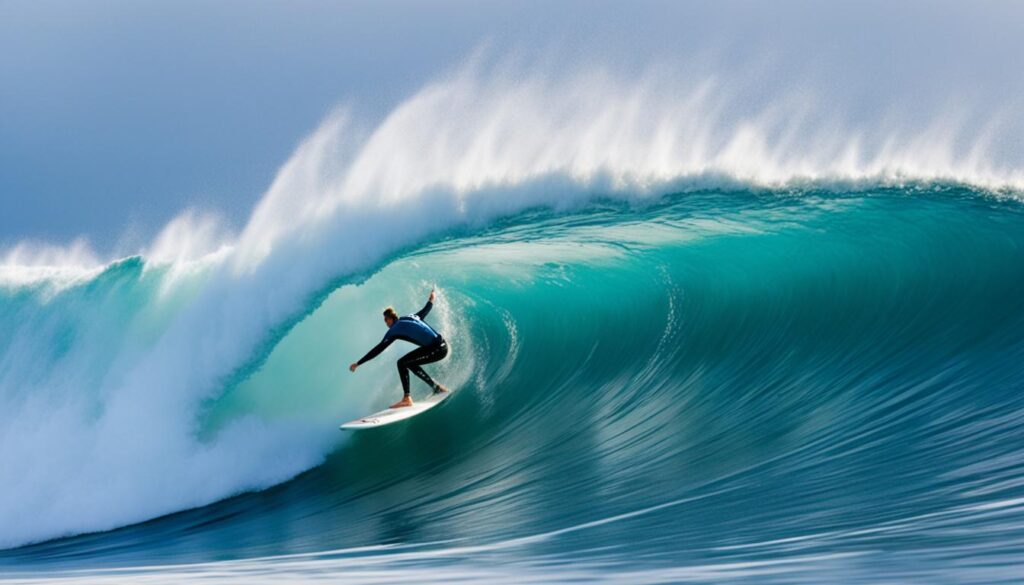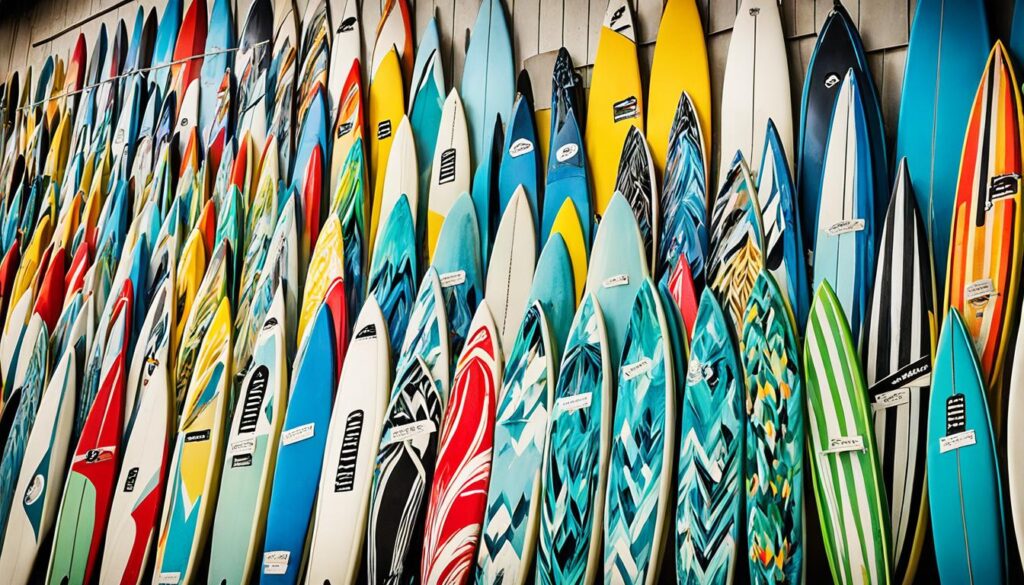Are you ready to take your surfing to the next level? It’s time to dive into the world of surfboard fins and discover how they can enhance your performance on the waves. With so many surfboard fin types available, it can be overwhelming to choose the right one for your board and surfing style. But fear not, this ultimate guide will break down the characteristics of different fin types, helping you make an informed decision.
From the traditional stability of a single fin to the speed and maneuverability of twin fins, each setup offers a unique surfing experience. But which one is right for you? And what about the elements of a fin that affect its performance, such as rake, splay, base length, foil, flex, and height? We’ll explore it all, giving you the knowledge you need to select the perfect fin.
So, whether you’re a beginner looking for stability and control or an experienced surfer seeking to push your limits, this guide will equip you with the information necessary to choose the right surfboard fin for your needs. Get ready to ride the waves like never before!
Key Takeaways:
- Surfboard fins come in various shapes and sizes, each affecting your ride on the waves.
- Understanding the elements of a fin, such as rake, splay, base length, foil, flex, and height, is crucial for choosing the right fin.
- Consider your ability level, weight, and the type of waves you’ll be surfing when selecting a fin.
- Different surfboard fin setups, including single, twin, thruster, quad, and bonza, offer varying levels of stability, speed, control, and maneuverability.
- Whether you prefer glassed-in fins or swappable fins, there are options available to suit your preferences and needs.
What Are Surfboard Fins and What Do They Do?
Surfboard fins are accessories made of fiberglass, plastic, or carbon fiber that attach to the bottom of your surfboard. They serve as control mechanisms, allowing surfers to pivot and change direction on a wave. The type of fin setup, the shape, size, and construction of the fins, and the type of waves and surfer’s ability all play a role in how fins affect your surfing performance.
When it comes to surfboard fin set-ups, there are various options to consider. Some surfers prefer a single fin for its stability and control, while others opt for twin fins for added speed and maneuverability. The thruster fin set-up, consisting of three fins, offers a balance between speed, control, and maneuverability. Those seeking maximum speed and drive may choose a quad fin set-up. And for surfers who desire speed, grip, and stability, the bonza fin set-up is a popular choice.
The shape and design of surfboard fins also play a significant role in performance. Fins can vary in shape, including upright, raked, or swept-back. The shape affects the control, speed, and maneuverability of the surfboard. Additionally, the size of the fins, as well as the material they are made of, impact the level of control and responsiveness.
“Surfboard fins act as control mechanisms, allowing surfers to pivot and change direction on a wave.”
When surfing, it’s essential to have the right fin set-up and shape that suits your surfing style and the type of waves you’ll be riding. Whether you’re an experienced surfer seeking high-performance fins or a beginner looking for stability and control, understanding the different surfboard fin options will help you make an informed decision.
Surfboard Fin Comparisons
| Fin Set-Up | Characteristics | Suitable Wave Conditions |
|---|---|---|
| Single Fin | Stability and control | Small to medium-sized waves |
| Twin Fin | Speed and maneuverability | Small to medium-sized waves |
| Thruster Fin | Balance of speed, control, and maneuverability | All wave conditions |
| Quad Fin | Speed and drive | Medium to large-sized waves |
| Bonza Fin | Speed, grip, and stability | Large-sized waves |
Types of Surfboard Fin Setups
When it comes to surfboard fin setups, there are several options to choose from, each offering a unique surfing experience. Whether you’re a beginner or an experienced surfer, understanding the different types of fin setups can greatly enhance your performance on the waves.
Single Fin
The single fin setup is the most traditional and classic configuration. It consists of a single fin placed in the center of the board. This setup provides excellent stability and control, making it ideal for beginner surfers or those who prefer riding in a straight line. Single fins excel at maintaining speed and delivering smooth turns.
Twin Fin
Twin fins feature two smaller fins placed side by side on the tail of the surfboard. This setup offers increased speed and maneuverability, allowing surfers to generate more drive and perform tight turns. Twin fins deliver a lively and playful feel on the waves, making them popular among surfers looking for a more dynamic and responsive ride.
Thruster Fin
The thruster fin setup is the most commonly used configuration in modern surfing. It consists of three fins, with a larger center fin and two smaller side fins. This setup provides a balanced combination of speed, control, and maneuverability. The center fin enhances stability and control, while the side fins contribute to improved maneuverability and responsiveness.
Quad Fin
A quad fin setup features four fins, with two larger side fins located near the tail of the surfboard and two smaller fins closer to the center. This setup prioritizes speed and drive, allowing surfers to generate incredible acceleration and maintain control even in critical sections of the wave. Quad fins deliver exceptional down-the-line speed and responsiveness, making them popular in fast and hollow surf conditions.
Bonza Fin
The bonza fin setup originated from Australia and is known for its speed, grip, and stability. It consists of a large center fin accompanied by smaller side fins positioned further forward on the board. This configuration offers excellent drive and hold in larger waves, providing surfers with a smooth and controlled ride. The bonza setup is ideal for powerful surfers seeking maximum speed and stability in critical conditions.
Choosing the right surfboard fin setup is essential for optimizing your surfing experience. Consider factors such as your skill level, surfing style, and the type of waves you’ll be riding. Each fin setup offers a different feel and performance, so take the time to experiment and find the setup that best suits your needs and preferences.
| Fin Setup | Description |
|---|---|
| Single Fin | The most traditional setup, providing stability and control for straight-line riding. |
| Twin Fin | Consists of two fins, offering speed and maneuverability for dynamic surfing. |
| Thruster Fin | The commonly used setup with three fins, providing a balanced combination of speed, control, and maneuverability. |
| Quad Fin | Four fins delivering speed and drive, ideal for fast and hollow surf conditions. |
| Bonza Fin | Offers speed and stability in larger waves, providing control and smooth rides. |

Understanding the Elements of a Fin
The elements of a surfboard fin play a crucial role in determining its performance. By understanding these elements, you can make an informed choice when selecting a fin that suits your specific surfing style. Let’s take a closer look at the key fin elements:
1. Fin Rake
The fin rake refers to the length of the front edge of the fin. It plays a significant role in both speed and turning ability. Fins with a longer rake offer enhanced stability at high speeds, making them well-suited for powerful waves. On the other hand, fins with a shorter rake enable sharper and quicker turns, making them ideal for maneuverability in smaller, more playful waves.
2. Fin Splay
Fin splay refers to the angle at which the fins stick out in relation to the surfboard’s stringer. This element directly impacts the responsiveness of the board during turns and maneuvers. Fins with a higher splay angle provide increased responsiveness, allowing for more dynamic movements. Conversely, fins with a lower splay angle offer enhanced stability, providing a smoother and more controlled ride.
3. Fin Base Length
The base length of a fin refers to the width of the fin where it attaches to the surfboard. This element influences both speed and maneuverability. Fins with a longer base length generate more drive and speed, making them ideal for long, fast rides. Conversely, fins with a shorter base length offer increased maneuverability, allowing for quick direction changes and tighter turns.
4. Fin Foil
Fin foil refers to the shape and design of the fin, which determines how water flows over and around it. Fins with different foil designs offer varying levels of lift and drag, directly impacting the board’s performance. There are various types of foil shapes, including flat foils, concave foils, and symmetrical foils. Each foil design has its own effects on speed, maneuverability, and stability.
5. Fin Flex
Fin flex refers to the degree of stiffness or rigidity in the fin. Fins with greater flexibility provide a looser and more playful feel, allowing for quick and responsive turns. In contrast, stiffer fins offer increased stability and control, providing a more predictable and precise ride. The choice of fin flex depends on personal preference and the desired surfing style.
6. Fin Height
Fin height refers to the vertical measurement of the fin from the base to the tip. It plays an essential role in controlling the stability and maneuverability of the surfboard. Taller fins provide more control and stability, making them suitable for larger waves or surfers who prefer a solid and predictable ride. Shorter fins offer increased maneuverability and responsiveness, allowing for sharper turns and more dynamic surfing.
By understanding these essential elements of surfboard fins, you can make informed decisions when selecting the perfect fin for your surfing needs. Now, let’s move on to the next section and explore how to choose the right surfboard fins for your specific requirements.
Choosing the Right Surfboard Fins
When it comes to choosing the perfect surfboard fins, several factors come into play. Your ability level, weight, and the type of waves you’ll be riding all influence your fin selection. One of the most important considerations is fin size. The right fin size determines the load-bearing capacity and maneuverability of your board, allowing you to optimize your performance in the water.
In addition to fin size, understanding your board’s fin configuration is crucial. Whether you opt for a single, twin, thruster, quad, or 5-fin setup can have a significant impact on your surfing experience. Each configuration offers its own unique advantages, such as speed, control, stability, or a combination of these factors. By choosing the configuration that aligns with your preferences and style, you can enhance your overall performance on the waves.
Another aspect to consider is the type of fin system: glassed-in fins or swappable fins. Glassed-in fins are permanently fixed to the board, providing a sturdy and reliable option. On the other hand, swappable fins offer versatility, allowing you to change your fin configuration easily. This option is particularly beneficial if you like experimenting with different setups or if you frequently switch between wave conditions.
Finally, understanding the dimensions and geometry of the fins, such as sweep, base length, foil, flex, height, and cant, can fine-tune your fin selection. Each element contributes to how the fin performs in the water, affecting aspects like speed, turning ability, control, and stability. By having a grasp of these fin characteristics, you can make informed choices that optimize your surfing experience.

